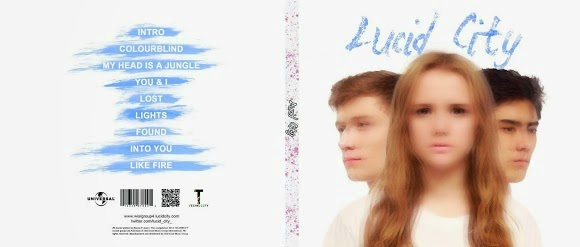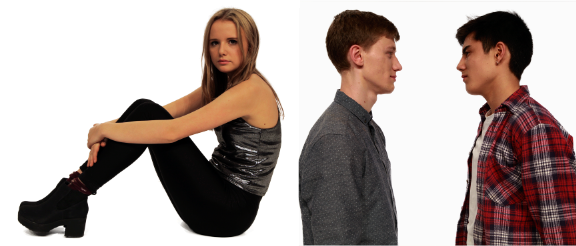- The scene opens with a wide shot which establishes where the scene is set, what time of day, etc. This moves in to a tracking shot to follow the carriages, which shows that they are a main focus in the scene.
- The camera zooms in to the carriage to show to characters sitting face to face. The side the characters are shown from doesn't change throughout the opening sequence and so doesn't break the 180-degree rule, which is essential for continuity.
- Then there are close-up shots of the characters loading their guns to show that it is significant; they are preparing for something. This gives the viewer an idea of what is going on as there is no dialogue to convey the story.
- The next few shots are a sequence of cross cutting between tracking shots of the main character, Sherlock, running from or towards something, and the shots following the carriages. The tracking shot allows the viewer to follow the story as it happens and the cross cutting suggests that the two separate scenes are happening simultaneously.
- Match on action is used between a shot of Sherlock jumping off a wall and the shot it cuts to, of him landing. This is helpful because it means the story can flow easily while still using a variety of different shots and types of framing.
Welcome to my A2 media coursework blog. My name is Maisie MacGregor (candidate number 0506), and I will be working in group 4 with Molly Sullivan (candidate number 0816), Ellie Brackpool (candidate number 0100), and Mari Leach (candidate number 0440).
To the right of my blog are labels for my A2 Preliminary task, A2 Research and Planning, A2 Construction and A2 Evaluation, and an archive of each individual post. There is also a live link to the Latymer Media Music Video Blog.
Click here to access Group 4's faceboook page.
Thank you for taking the time to look at my blog.
Thursday 26 September 2013
Film opening continuity analysis
Accident Sequence - Continuity
a) What techniques did you specifically use to create continuity (narrative flow) in your accident sequence?
The first shot is a pan following Matt walking down a corridor. This establishes the setting and focuses on at least one of the main characters so that the viewer knows the story will take place in a school and that this character is involved.
The second shot shows Seb's feet as he is running down the stairs, which creates suspense for the viewer as they haven't seen this character's face yet, and also adds pace to the narrative as he is obviously in a hurry.
The next shot cross-cuts back to an over the shoulder shot of Matt, still walking down the corridor, to show his point of view of the situation. The feel of this shot is calmer and slower paced, which helps to convey that the two scenes are happening separately.
Then it cuts to a wide shot which shows the corridor and the stairs, and the characters bumping in to each other. This puts in to perspective for the viewer where the shot is taken in relation to where the characters were before.
The last shot is a low angle shot that shows Matt lying on the floor where he was knocked down and Seb running away. This shows the outcome of the 'accident' and finishes off the story we were trying to tell.
b) In hindsight, what could you do to improve the continuity of the sequence?
I would change the type of shot we used for the final shot as it isn't clear that Seb is running in the same direction he was running in in previous shots. I would also use a wide shot to establish the location rather than a panning shot as it provides more information about the setting and could be used as a master shot to cut back to, to make it obvious where everything is happening.
Sunday 22 September 2013
Film Opening Analysis
The opening scene establishes the setting of the film with a wide shot of the school and the voice-over saying that it is located in Illinois, USA, in 1984. Then the voice-over tells us an outline of the story, that the characters are told to write an essay about themselves during their detention, while there is a montage of shots from around the school which reveals more about the setting: we see that it is a typical American high school and that at the moment it is empty.
Before we see the characters, the voice-over describes them as "a brain, an athlete, a basket case, a princess, and a criminal". This tells us a little bit about their personalities and which stereotype they fit in to. We are properly introduced to them one by one with a short scene of them arriving at school. It is clear which clique they represent from the conversations they have - or don't have - with their family or from their actions, and it is also clear that these are the five main characters of the story.
The events in the opening scene don't follow on from each other but they are connected in a way because the same situation is shown from the viewpoint of each character.
Not too much information is given to the audience in the opening, but it is enough to interest them in the film as they have an idea of where the film is set and the situation. Most information about the characters is not revealed straight away but is developed as the film goes on.
Thursday 19 September 2013
Film Still Analysis
Our task was to take shots to represent a particular genre of film, and the genre we were trying to achieve in this shot was horror.
Representation of Genre
We used the basement as the setting for this shot as it is dark and gloomy, which is a very generic setting for a horror film, but also contains everyday items such as the ladder, making the story seem more real and therefore making it more effectively scary. The character in this shot is a girl crouched, facing the corner in the dark. Her position suggests she afraid of something or trying to protect herself, and the high angle it is shot from makes the character seem smaller and more vulnerable as the viewer is looking down on her. This shows the viewer that there is something or someone that could be dangerous, which is often the case in a horror film.
How this was achieved
We decided to use a dark and creepy looking location to represent the tone of the movie as dark and scary with the low key lighting. Although most of the scene is in darkness, there light casting a shadow of an unknown hand and this emphasises it as the main focus. The fact that the viewer doesn't know who or where the hand is coming from creates suspense and tension, which is a common theme in the horror genre.
Successful?
I think the lighting in this shot is successful as it is mainly low key to match the tone of the film, with brighter lighting to highlight more important elements of the shot, for example the shadow of the hand on the wall.
Improvements that could be made
The representation of the character could be better, as it's not clear exactly where the girl is or why she is in this situation. To improve this we could have included the stairs in the shot to show a more precise location, or used other props in he background to provide more information.
Representation of Genre
We used the basement as the setting for this shot as it is dark and gloomy, which is a very generic setting for a horror film, but also contains everyday items such as the ladder, making the story seem more real and therefore making it more effectively scary. The character in this shot is a girl crouched, facing the corner in the dark. Her position suggests she afraid of something or trying to protect herself, and the high angle it is shot from makes the character seem smaller and more vulnerable as the viewer is looking down on her. This shows the viewer that there is something or someone that could be dangerous, which is often the case in a horror film.
How this was achieved
We decided to use a dark and creepy looking location to represent the tone of the movie as dark and scary with the low key lighting. Although most of the scene is in darkness, there light casting a shadow of an unknown hand and this emphasises it as the main focus. The fact that the viewer doesn't know who or where the hand is coming from creates suspense and tension, which is a common theme in the horror genre.
Successful?
I think the lighting in this shot is successful as it is mainly low key to match the tone of the film, with brighter lighting to highlight more important elements of the shot, for example the shadow of the hand on the wall.
Improvements that could be made
The representation of the character could be better, as it's not clear exactly where the girl is or why she is in this situation. To improve this we could have included the stairs in the shot to show a more precise location, or used other props in he background to provide more information.
Subscribe to:
Posts (Atom)



